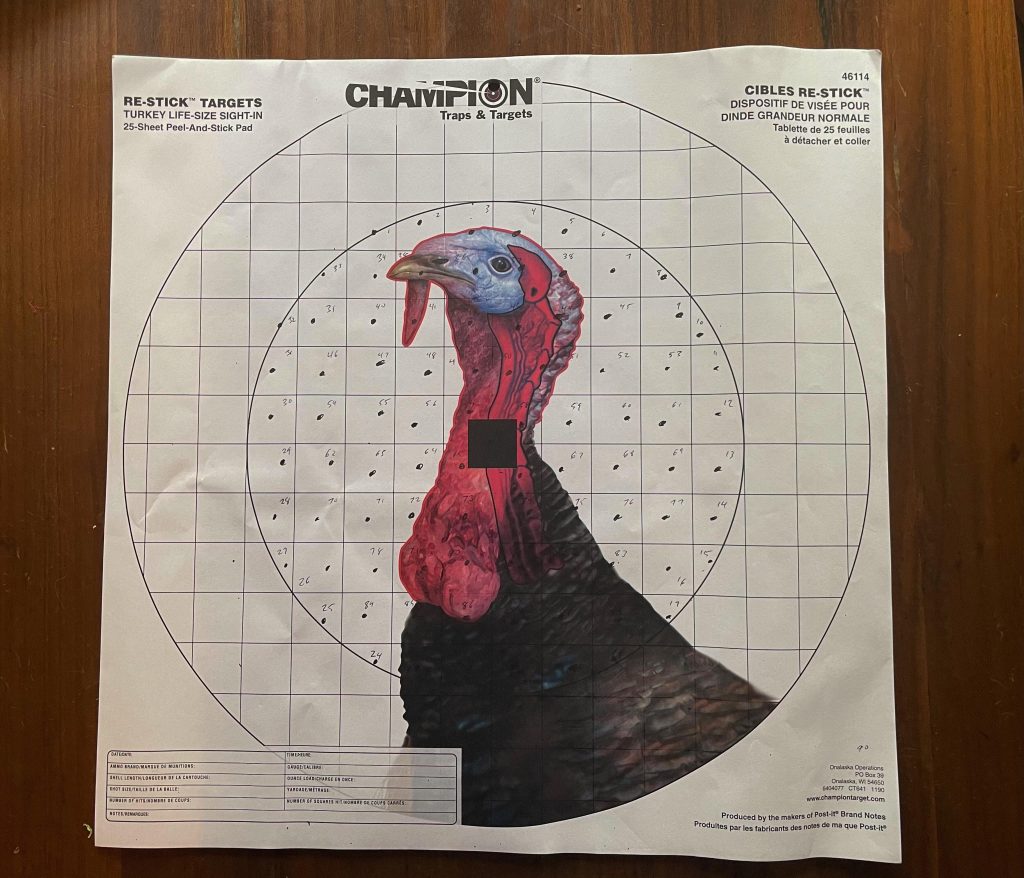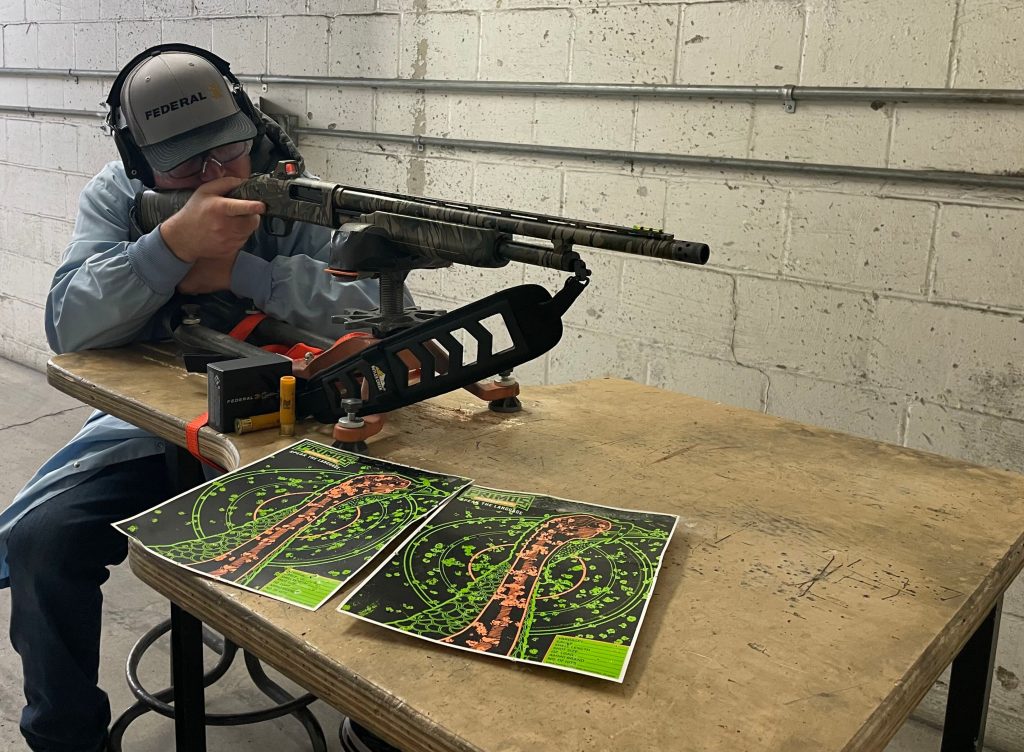Is the Age-Old Pattern Rule Still Viable?
Evaluating the 100-10-10 rule of thumb for patterning a turkey gun to see if it’s still valid today.
When patterning a turkey gun, the common recommendation is to achieve at least 100 pellets within a 10-inch circle, with at least 10 pellets in the turkey's vital area. This 100-10-10 pattern helps ensure a high likelihood of fatally hitting the head and neck area, regardless of the turkey's position — front-facing, sideways or facing away — and is considered the longtime standard for achieving a quick and clean kill.
Historical Reference
I have been hunting turkeys for 25 years and have always heard the 100-10-10 standard, so I know it has been around for a long time. However, I paged through a few of my old turkey-hunting books from the 1980s and 90s to establish a historical reference.
Several of the old books stated that it only takes one pellet striking the vital areas of the skull or vertebrae in a turkey’s head to be fatal. However, those authors always recommended that you have more than one hit is always a good idea.
“Two or more pellets in the head or upper neck indicate a killing pattern,” was noted in the book On Target for Successful Turkey Hunting by J. Wayne Fears, copyright 1983.
“You need at least four pellets in the lethal head and neck area,” was stated in the book Secrets of the Turkey Pros by Glenn Sapir, copyright 1999.
I then found a detailed article from the book Wild Turkey Hunting, published by the National Rifle Association, copyright 1988. That article stated: “As a general rule, No. 4, to be effective, should connect with eight pellets, and No. 6 should consistently send home a full dozen.”
Eventually, someone along the way established the age-old rule of thumb of 100-10-10. Curiously, I did the math to evaluate the logic behind that standard, and the math checked out.
The Math Checks Out
A 10-inch circle is 78.5 square inches, so 100 pellets is 1.27 per square inch. A turkey's head and spinal column in the neck represent about 4 square inches (conservatively), so 4 times 1.27 equals approximately five pellets in the skull and neck vertebrae. This means only 80 pellets (rounding up) in a 10-inch circle could cover every square inch of the target. This includes approximately five direct hits in the skull and vertebrae, where it only takes one for the kill.

Here is a look at this math in a more practical way. Champion Target’s turkey-hunting patterning target features a turkey head and neck inside a 10-inch circle with 1-inch square gridlines. The circle encompasses about 90 of those one-inch squares, and the vitals are depicted in about nine of those squares. This means 90 pellets (rounding up) in a 10-inch circle, with nine pellets in the vital area, has the potential to hit every square inch of the target.
The bottom line is that the 100-10-10 standard is likely more than enough to completely cover a turkey’s kill zone within a ten-inch radius, allowing forgiveness (wiggle room) if the turkey moves its head or the shooter’s aim is slightly off. This standard has been around for decades, and because it was good enough for turkey hunting back then, it should be good enough now.
Patterning in Modern Times
However, many turkey hunters don’t use targets with 10-inch circles; they use more convenient targets made from 8.5-inch by 11-inch standard-size paper. So, how does the 100-10-10 standard apply to that type of target?
The area of an 8.5-by-11-inch rectangle is 93.5 square inches. That is approximately 20 percent more than that of a 10-inch circle. So, the standard could be translated to 120 pellets spread somewhat evenly on the 8.5-by-11-inch paper, with 10 pellets in the vitals (naturally, that number stays the same).
It’s important to note that the 100-10-10 standard was established when hunters shot lead loads at a common sight-in distance of 25 yards. A magnum 12-gauge, 2-ounce, No. 5 lead load, typically used then, has an average pellet count of 340.
Today, enhanced turkey guns, optics, chokes and shotshell loads can achieve that standard at greater sight-in distances, such as 40 yards, now a more typical sight-in distance.
And when shooting ultra-dense Tungsten Super Shot (TSS), hunters can significantly downsize in pellet size due to those projectiles still retaining velocity and downrange energy the same or better than larger lead pellets. A typical magnum 12-gauge, 2-ounce, No. 9 TSS load has an average pellet count of 717.
This means it’s not uncommon for hunters shooting TSS to evaluate a turkey load by doubling or tripling the standard because they have twice or three times the number of pellets. They are likely evaluating their loads with an increased standard, such as 200 or 300+ pellets in a 10-inch circle with 20 or 30+ pellets in the vitals at 40+ yards.

I recently checked zero on a Mossberg 500 Turkey — Holosun Micro Dot Combo in the underground testing range at the Federal Ammunition factory in Anoka, Minnesota. I shot a Federal Custom Shop 20-gauge, 1 3/4-ounce, No. 9 TSS load with a 627 average pellet count at a Primos Hunting paper target.
At 30 yards, my pattern showed 359 pellets on paper with 71 in the vital area. At 50 yards, it was 152 pellets on paper with 25 in the vitals. That result was way more than the 120-10 rectangle-target standard, and the pattern was evenly spread across the entire piece of paper with no large gaps, so I was pleased.
In Conclusion
Yes, the well-established 100-10-10 standard for patterning a turkey target is still viable today, depending on the situation. It all boils down to understanding what exactly you are shooting and what that turkey load is capable of.
The 100-10-10 pattern is certainly a good guideline to consider when shooting a turkey load with a smaller pellet count of 350 pellets or less, such as a .410 bore, 13/16-ounce, No. 9 TSS load, which has an average pellet count of 311. It is also a good guideline when shooting a more open choke, which offers more forgiveness at close range, or when patterning a target at a distance beyond 45 yards.
On the other hand, when shooting TSS loads with very high pellet counts, hunters can certainly evaluate patterns at two or three times the standard. Given the significant pellet-count increase TSS provides, that makes sense.
